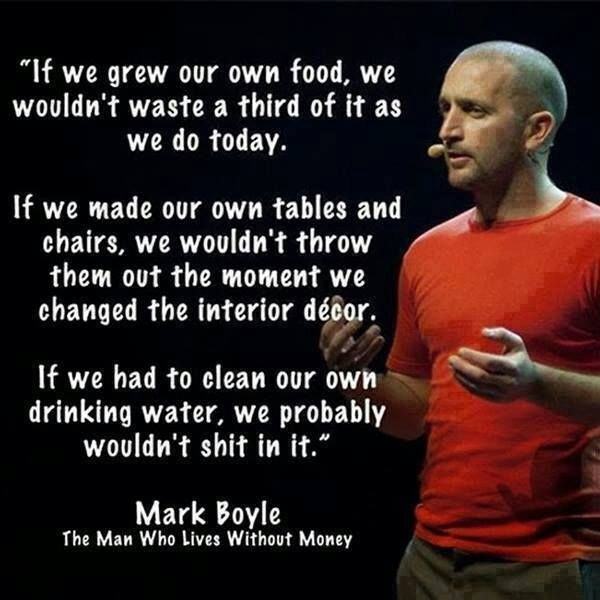I just finished reading Mark Boyle’s book The Moneyless Man and found it hugely inspiring. Mark was an economics graduate and businessman who discovered Ghandi. Ghandhi’s “Be the change you wish to see in the world” became the ethos by which he began to live and Mark started a Freeconmic movement, one in which members gave freely to those in need. This movement operates in over 150 countries around the world in town and city communities. The Freeconomic Movement operates on a Pay-It-Forward ethos. As he puts it in his speech (linked below) “For thousands of years we have been looking at life through a lens of “What can I take”. Imagine on a table in front of you there are different lens and we take off our old and put on a new one of “What can I give?”
“Imagine a world where we can give without expectation of receiving anything in return to someone who needs help.”
From an ecological viewpoint Mark discusses the toll consumerism has taken on the planet, the wasteful nature of it. In the UK 1/3 of all food traded through supermarkets etc is wasted, thrown out by either the stores or the consumer – much of this food imported from all around the world just to be dumped. Much of this food is grown by poorer countries who use low paid workers to produce it, the expense of getting it to our shops/homes grows with every step of the journey not only adding to the cost of the product but it takes a toll environmentally…then so much of it is dumped. The same could be said for many of our purchases which end up in landfills sooner or later.
From a humanitarian viewpoint, how much food, warm clothing, furniture etc is dumped when so many have so little and go hungry, not in only third world countries but in our own?
In late 2008 Mark made a commitment to try living one year without money. He advertised on Freecycle for something he could live in and was given an old caravan, he made a rocket stove to cook on. He found an organic farmer who was willing to let him live in a small area in return for some work. He dug a hole to use as a loo, surrounded it with a makeshift tent he could also use as a camp shower. He also was given a fire and used waste wood to heat his caravan. He used an old bike to get around or walked many miles many days. He grew his own food, foraged and went skip diving. He talks of feasts him and his friends threw for up to 1500 people on waste from supermarkets, donations from many different sources (though I expect his profile in the area possibly helped alot there) He not only survived the in the year but at the end of his time realised how much happier he was, that he was a better person for it and decided to stay. The proceeds from his book are going towards land for a Freeconomy Community to set up their own place and this will not be a closed community but an open one.
Few of us would be willing or feel able to give up money, for those who would like to he shows it’s possible. But I found him inspiring for many reasons …he puts his money (or lack of!) where his mouth is, he fosters generosity rather than greed, he raises awareness of all sorts of ecological and society issues, he is a man who has taken up the “Be the change you wish to see in the world” challenge and run with it expecting nothing in return. His Freeconomy communities run much like Freecycle, people can advertise for stuff they need whether it be a lift somewhere, a couch to sleep on, tools, food…whatever. People can trade good for services or skills or just give freely. I am seriously considering starting one up here in our town but it does need thinking about. There will always be the takers who use something like this the wrong way, there is always potential for not so nice people in society to take advantage but… there are alot of good reasons to do this too. Many years ago I belonged to a Green Dollar Community where people traded skills and items with others expecting they in turn will recive what they need from others. I became very frustrated by doing alot of work for others who weren’t prepared to do their bit in return. This is different, there is no expectation here that you will receive anything in return, only that those you give to may one day pay-it-forward. People can get together to hold book or clothing swaps, family days etc. As an introvert I find this idea a bit scary 🙂 as a person who does care about the effect poverty has on people and communities I think it’s a brilliant idea. Anyway….bears some consideration.
To watch Mark Boyle’s talk on Ted X see here It runs for 15 minutes. Or an article he did for The Huffington Post here
The Sydney Morning Herald did an article on the rise of this in Australia while people are finding things tough and it appears to be successful and well used.




